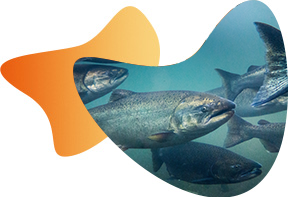Originally published : Thu, September 2, 2021 @ 2:55 PM
Updated : Tue, September 7, 2021 @ 7:59 PM
Aquaculture breeding programmes adopt genomic technologies, including genotyping, to increase genetic gain for specific traits of interest. Breeders can employ these technologies to improve the prediction accuracy of breeding values among candidate populations and – in some species – shorten generation intervals. Tissue sampling is a critical step in the genotyping workflow, and following best sample practices will help ensure accurate, reliable data to base decisions. Here are four steps that can provide a solid foundation for your sampling protocol.
-
Plan the project
Before any sampling commences, be sure you’ve considered the number of individual fish samples you’ll need for reliable decision making. From there, you’ll also need to determine the number of fish fin punches needed per sample to get accurate results. If you’re unsure, contact the lab that will be analysing the samples to discuss your project and ensure the proper protocol is in place.
Next, review the sampling protocol that you’re planning to use. Be sure that you’ve collected the necessary tools for sampling, documenting and shipping before you begin. Standard necessities might include sampling tubes or plates, paper punch or scissors, sampling mat, shipping containers and any necessary paperwork for shipments. If you’re using a sampling kit, familiarise yourself with the contents and manufacturer’s instructions before sampling. Finally, ensure you’ve allocated enough time and space to collect samples without feeling rushed or stressed. -
Sample carefully
Next-generation sequencing for genotyping in aquaculture applications requires intact, high molecular weight DNA that results from high-quality DNA extractions. Proper sample collection is a critical step for obtaining the highest quality tissue for DNA extraction.
A 5 mm piece of tissue (about the size of a pencil’s eraser) is sufficient for several separate DNA extractions and subsequent PCR analyses. Compared with scissors or scalpel, a punch tool for fin sampling results in more consistent sample sizes and DNA concentrations, which could improve data quality. The instrument used to collect the tissue should be cleaned after each unique sample to avoid cross-contamination. Wiping or rinsing the cutting tool with clean water to ensure that no tissue or blood residue remains reduces the risk of sample contamination issues.
Properly preserving the collected DNA is vital for successful extraction.
There are several methods to preserve DNA for aquaculture projects, including ethanol, freezing and desiccants. While ethanol is a common preservative used in tissue sampling, it does add some complications to the workflow. Ethanol can create logistical challenges for shipping samples and storage. An average genomic selection experiment (approximately 3,000 samples) requires about 15 L of 70% ethanol, which is costly, challenging to store and expensive to ship. The production and shipment of ethanol also require extra resources that increase energy consumption and carbon emissions, which is not environmentally sustainable. Further, DNA could degrade if the ratio of fin tissue to ethanol is too high in the sample vial.
There are similar challenges with frozen samples – heavier packages result in higher shipping costs and require extra packaging materials that may not be environmentally friendly. Sample quality can also be compromised if frozen samples defrost during transit, resulting in degraded DNA and low-quality data. -
Identify samples accurately
As you’re sampling, be sure to identify each sample correctly. Use unique identifiers and be sure to double-check each tissue sample for accuracy before placing it into a sampling tube or well. Many labs offer electronic sample submission forms or plate maps that can simplify sample documentation and identification.
If possible, don’t include labels inside the sampling vials, regardless of the DNA preservation method you’re using. Identification labels inside tubes or wells can be difficult to remove and can increase the risk of sample contamination. In addition, labels may contain bleaching agents that can inhibit the detection of the target DNA.
If you plan to use ethanol to preserve sample DNA, beware that leaking during transport could dissolve any identification written in pen or Sharpie on the outside of tubes. Use a reagent resistive marker or pencil for identifying vials instead. -
Ship properly
When your samples are ready for shipping, be sure to review your lab’s procedure for sample submission. Depending on the preservation method chosen, there could be different requirements for packaging shipments. For example, frozen samples will need to remain frozen for the duration of the trip to the lab, which will require additional packaging and logistical considerations.
Ethanol is a flammable liquid, so shipping large quantities of samples may qualify your package as “dangerous goods”. That could prompt the need for special packaging and transport, requiring extra costs. Finally, if you’re planning to ship samples internationally, there could be additional requirements and paperwork to process.
The genotyping data you receive for your aquaculture project is only as good as the samples you submit. Each step of the sampling process has the potential to limit data quality. LGC, Biosearch TechnologiesTM simplifies sample collection with the BioArk Fish Collection Kit. It addresses some of the biggest challenges with aquaculture tissue collection, including storage and shipping logistics and obtaining and preserving quality DNA. The BioArk Fish Collection Kit allows users to:
- Generate reliable data from consistent sample quality, size, and shipping stability
- Reduce sampling time compared to traditional methods
- Reduce plastic consumption, hazardous ethanol, energy consumption and carbon emissions compared to conventional sampling methods
- Simplify shipment and customs clearing
- Eliminate additional shipping fees associated with traditional sampling methods
- Map samples to specific wells for accurate identification
Learn more about how the BioArk Fish Collection Kit can support your aquaculture sampling projects.

